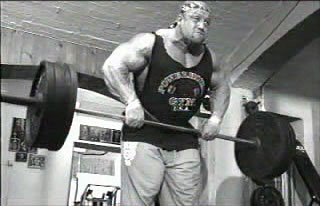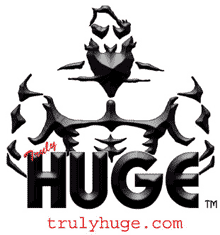
Click Here for Free Bodybuilding and Fitness Magazine Subscription
Dorian Yates Blood & Guts Workout Routine
He trains in a similiar manner to Mike Mentzer's Heavy Duty style. The essence is that the workouts are quick and intense. They rest just long enough for the other guy to finish his set. They train heavy, in good form, intense, and then they're outta' there!
The following article will give you more info on why High Intensity is The Best Way to Train.
I. What is High Intensity Training?
High Intensity Training (HIT) is a form of strength training popularized in the 1970s (first by Arthur Jones of Nautilus and Medx fame) and presented as the super-efficient antithesis of the current 'volume' approach to bodybuilding.
Its principles are progression (the trainer adds more weight to the bar/machine session each session as they attain greater strength), and overload (where the muscles are forced to hypertrophy or thicken by being exposed to above-normal levels of stress).
More weight/repetitions are added to the bar/machine in consecutive workouts as the trainer adapts. It may be summed up with the philosophy of 'intense, brief, and infrequent'.
* Intense: Each set of repetions of an exercise is taken to the point where another repetition is not physically possible (known as "training to failure").
* Brief: Most workout sessions are limited to under 45 minutes or less, as intensity is inverse to volume, and muscle growth is stimulated via intensity.
* Infrequent: High intensity training has such a stressful affect on the body (needed to force the body to grow muscle and so adapt) that training sessions are usually limited to three, two or even one workout per week.
In HIT, each exercise would be conducted in a smooth manner with no jerking of movement. If the prescribed number of repitions is achieved for an exercise in a workout, then for the next workout the weight for that exercise is increased by a very small increment in order to expose the muscle to new stress and keep the body growing. If in doubt, number of rest days between workouts is increased. The workout serves to stimulate muscle growth(not grow muscle). The body needs time to recuperate and adapt and grow after a workout.
II. Why High Intensity Training?
High Intensity Training is the fastest, safest, surest, most efficient, and most easily measured system for achieving muscular growth. To explain why I will have to explain a little more about muscle growth.
Changes in muscle size are governed by two processes: Anabolism and catabolism. Anabolism means buildup, repair, or growth of the muscle, while catabolism means the breakdown of muscle. Both of these processes are continuous, and are normally well balanced. That is to say, most people create as much muscle, more or less, as they destroy.
1. Muscle Anabolism:
Anabolism is an ongoing process in everyone. In sedentary individuals only enough anabolism occurs to offset (or almost offset) the normal catabolism. If this didn't happen, people would rapidly waste away whenever they got hungry or experienced any stress.
Resistance training, when done with enough intensity, stimulates an anabolic response. The body can be "tricked" into "thinking" that it needs to become stronger when it is stress at the limits of its strength. Only high intensity work will cause an anabolic response. If high volume, low intensity work stimulated anabolic responses long distance runners would have large quadriceps. They, in fact, do not.

2. Muscle Catabolism:
Catabolism occurs in every person regardless of lifestyle or training level. We can see this because unused muscles, such as those immobilized by casts or those in comatose patients, atrophy. Catabolism is governed by various hormonal systems as well as by mechanical stress. In other words, elevated general stress levels (such as those experienced by people who are overworked) as well as specific mechanical stress (such as that inflicted by resistance training) are catabolic. That's right, weight training is catabolic, not anabolic. That's why resistance training often leads to muscle soreness - the soreness is an indication of muscle damage.
There are many ways to prevent catabolism. Eating frequently keeps blood sugar levels high, which keeps the body from cannibalizing muscle tissue for energy. Various drugs (so-called anabolic steroids among others) interfere with the body's natural hormonally regulated catabolic processes.
Obviously, any reduction in catabolism, if the rate of anabolism remains constant, will result in an increase in the rate of muscle growth. The rapid muscle gains experienced by steroid users show this.
3. The Right Amount of Exercise: One Set
It should be clear now that in order to maximize the rate of muscle growth it is necessary to train in such a way that the rate of anabolism exceeds the rate of catabolism by the greatest amount. We need to train in such a way that we can both stimulate a large anabolic response yet minimize the catabolic effects of training.
Remember, we need to operate near the body's strength limit in order to stimulate anabolism. We also need to minimize training volume, for training itself is catabolic. The best way to do that, for most natural bodybuilders, is to perfom one set per muscle group, done to failure. By working to muscular failure we are sure to tax our body's strength. By performing only one set we are doing our best to minimize exercise induced issue breakdown.
Click the links below for more information:

